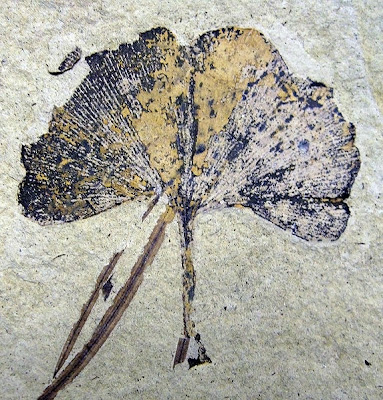Some Ginkgo pics from wikimedia commons. Anxious to move my 7 ft tall (maybe 8 foot tall) Ginkgo from the front yard to the place in Battleground. That will leave 2 at home from the seeds my Dad collected 15 years ago. The one that I plan to move was in a flower pot for several years, so is behind the others in growth and therefore should be movable. I don't want to kill it. Will await dormancy or rains or both. Once it's here in Battleground, the place will feel a lot more like home to me.
According to about.com, the species Ginkgo adiantoides, which is indistinguishable from the modern Ginkgo biloba, "flourished in the early Cretaceous epoch, 140 to 100 million years ago", the ginkgo's "heyday". They state that the earliest fossils are from the Permian age, 280 million years ago.
*
Described as " Fossil of Ginkgo huttoni... Naturalis museum, Leiden"
Described as "Ginkgo sp. from the Jurassic Cloughton Formation. Locality - Scarborough, Yorkshire, England"
Not much description.
Described as "Miocene ginkgo wood cross section, Ginkgo sp. from the Children's museum of Indianapolis."
Listed as "Ginkgo dissecta. A 5cm wide leaf with typical 4 lobed structuring. Illustrated in Mustoe 2002 as SR 96-09-01. Ypresian, 49 million years old, "Boot Hill", Klondike Mountain Formation, Republic, Washington, USA. Stonerose Interpretive Center Collection "
Described as "Fossil of Gingko adiantoides, at Fossil Show, Munchen 2011; apparently from North Dakota, paleocene epoch.
Not much description for this one.
Described as "Ginkgo biloba. Eocene fossil leaf from the Tranquille Shale of MacAbee, British Columbia, Canada"
Described as "A 70mm wide Ginkgo biloba leaf. Klondike Mountain Formation, Republic, Ferry County, Washington, USA, Eocene, Ypresian, 49 million years old. Stonerose "
*
According to wikipedia, Ginkgo biloba had a slow rate of evolution of the genus. The authors speculate that "Ginkgo represents a preangiosperm strategy for survival in disturbed streamside environments... evolved in an era before flowering plants, when ferns, cycads, and cycadeoids dominated disturbed streamside environments, forming a low, open, shrubby canopy. Ginkgo's large seeds and habit of "bolting" - growing to a height of 10 m before elongating its side branches - may be adaptions to such an environment."
Not a fossil, just a beautiful pic. The local gingko "fruits" are still hard and green, and the leaves are still green - but getting closer. A little more pale. Also anxious to collect another batch from my source, a pair of female trees in an otherwise male row, in Vancouver WA. Not sure if the one down the street from me is still there and dropping seeds - I should check.
*
It will be fun to start more, and share more. Will send some to Raymond in Alabama.









No comments:
Post a Comment